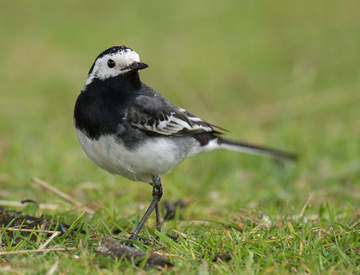
Pied Wagtail © Sue & Andy Tranter
This is one of our most familiar commensal birds, both by sight and sound, its loud ‘chissick’ calls being unmistakeable, although the softer ‘chewee’ indicates a bird on territory. Its close link with man was shown by the submitted habitat codes: more than half of them were human sites, especially rural ones, with most of the remainder being farmland, mainly grassland. Pied Wagtails feed mainly on adult flies, which they catch by a combination of picking off the surface and flycatching near to the ground if their prey is disturbed into flight (Simms 1992). They noticeably gorge themselves, and feed their chicks, on temporarily abundant species such as mayflies and craneflies. This prey is most likely to be found on close-cropped grass, grazed farmland being ideal, or mown lawns, bowling greens, playing fields and other sports areas; open areas in man-made sites, such as roads, car parks and farmyards, also attract the species.
Breeding was confirmed in two-thirds of the tetrads with records, most of them by observers seeing recently-fledged chicks or adults carrying food. With two broods normal, they can be feeding chicks over an extended period, from early May to late July. The nests themselves, however, can be difficult to find and are usually well hidden on a ledge somewhere. Observers reported nest-sites in ivy and other climbing plants and in a variety of human artefacts including a pub window sill and canal lock gates. In the eastern hills dry stone walls offer plenty of nooks and crannies, and one pair was seen taking nest-material into the roof of the highest pub in Cheshire – the 'Cat & Fiddle' Inn – and later seen carrying food. Most sand-quarries have a pair, who can pick plenty of insects off the warm sand, and find a nesting site somewhere amongst the machinery or buildings. They are not deterred by human presence or by the noise and movement of machinery. One pair nested in 1989 and 1990 on a ledge under a sand-quarry weighbridge, raising six chicks each year as hundreds of heavily-laden lorries passed overhead during the four weeks of the incubation and fledging periods.
The monitoring schemes show that Pied Wagtails exhibit annual fluctuations in breeding population, especially being depressed by hard winter weather, but the national index is now at a similar level to that during our First Atlas. Their occupation of Cheshire and Wirral is similar to twenty years ago, despite the figures of 60 tetrads gaining and 63 losing the species. They have increased in a range of tetrads along the centre of the county, where they were thought to have been under-recorded in the First Atlas, and have spread more into the Mersey valley and north Wirral, including now breeding on Hilbre. There is no obvious pattern to the tetrads without breeding season records, although there are noticeably fewer tetrads with confirmed breeding in the eastern hills.
The BTO BBS analysis shows that the breeding population of Cheshire and Wirral in 2004-05 was 20,120 birds (7,020-33,230), corresponding to an average of about 21 pairs per tetrad with confirmed or probable breeding, or 17 pairs per tetrad in which the species was recorded. This is almost 2% of the national total, showing that Cheshire and Wirral is a favoured county for them.
Sponsored by Norman Scott

